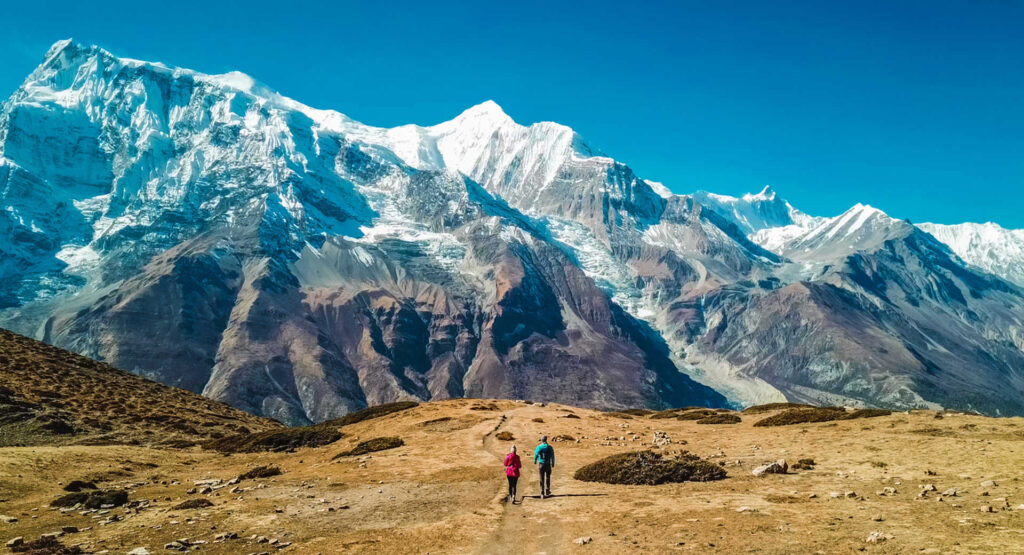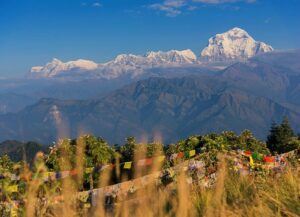Nestled in the majestic Himalayas of Nepal, the Annapurna Circuit stands as a beacon for trekking enthusiasts seeking unparalleled natural beauty and cultural immersion. This iconic trek is renowned for its diverse landscapes, from lush subtropical forests to barren high-altitude deserts, and its panoramic views of some of the world’s highest peaks, including Annapurna and Dhaulagiri. Spanning approximately 160-230 kilometers (100-145 miles), depending on the route chosen, the Annapurna Circuit promises an unforgettable journey through a variety of ecosystems and cultural experiences.
The Annapurna Circuit offers trekkers a remarkable diversity of landscapes, starting from the lush foothills of the Himalayas with terraced fields and subtropical forests teeming with rhododendron and bamboo. As trekkers ascend, the scenery transitions into alpine meadows adorned with blooming wildflowers during spring, and eventually into arid, barren landscapes resembling Tibetan plateaus at higher elevations.
Beyond its natural splendor, the Annapurna Circuit is a cultural mosaic, home to diverse ethnic communities such as Gurungs, Thakalis, and Manangis, each with their distinct traditions, languages, and architecture. Villages along the route offer opportunities to experience authentic Nepalese hospitality and witness daily life in remote mountain settlements.
The Annapurna Circuit poses various challenges, including crossing the Thorong La Pass (5,416 meters or 17,769 feet), one of the highest trekking passes in the world. Acclimatization stops in villages like Manang and Yak Kharka help trekkers adjust to the thin air, ensuring a safer ascent to the pass. The reward for this effort is breathtaking views of snow-capped peaks stretching across the horizon.
Trekkers can choose from several route variations on the Annapurna Circuit, each offering unique experiences. The classic route typically starts from Besi Sahar and follows a clockwise or counterclockwise loop via Manang, Thorong La Pass, and Jomsom. Variations include detours to Tilicho Lake, one of the highest lakes in the world, or extending the trek to include the Annapurna Base Camp.
Proper preparation is essential for a successful Annapurna Circuit trek. Trekkers should obtain necessary permits, such as the Annapurna Conservation Area Permit and Trekker’s Information Management System (TIMS) card. Packing essentials include sturdy hiking boots, warm clothing layers, a sleeping bag suitable for cold temperatures, and a comprehensive first aid kit.
The best time to trek the Annapurna Circuit is during the pre-monsoon (spring) and post-monsoon (autumn) seasons, from March to May and September to November, respectively. These periods offer clear skies, moderate temperatures, and spectacular views of blooming rhododendron forests or autumn foliage.
The Annapurna Circuit is more than just a trek; it’s an immersive journey through Nepal’s natural and cultural heritage. Whether marveling at the sunrise over Annapurna’s peaks, interacting with friendly locals in mountain villages, or conquering high-altitude challenges, every step on this circuit is a testament to the allure and grandeur of the Himalayas. For trekkers seeking an unforgettable adventure in one of the world’s most captivating landscapes, the Annapurna Circuit stands as a true trekker’s paradise.
Introduction: Exploring the Magnificent Annapurna Circuit
The Annapurna Circuit is celebrated as one of Nepal’s most iconic trekking routes, offering adventurers a blend of stunning landscapes, rich cultural experiences, and challenging high-altitude passes. This trek circumnavigates the Annapurna massif, showcasing diverse environments from subtropical forests to arid high-altitude plateaus. Trekkers are treated to panoramic views of snow-capped peaks including Annapurna, Dhaulagiri, and Machhapuchhre (Fishtail), making every step a visual feast.
Destination Overview: Annapurna Region – Trekker’s Paradise
Located in central Nepal, the Annapurna region Trek is renowned for its natural beauty and cultural diversity. The circuit spans approximately 160-230 kilometers, depending on specific routes and side trips chosen. Trekkers encounter a variety of landscapes ranging from terraced fields and lush forests in the lower valleys to alpine meadows and barren, rugged terrain at higher elevations.
Cultural highlights include encounters with Gurung, Thakali, and Manangi communities, each with distinct traditions and lifestyles. Villages along the route offer opportunities to experience local hospitality, visit ancient monasteries, and observe daily life in remote mountain settlements.
Planning Your Trek: Essential Preparations and Logistics
Planning for the Annapurna Circuit trek involves several key preparations. Obtain necessary permits such as the Annapurna Conservation Area Permit (ACAP) and the Trekker’s Information Management System (TIMS) card from the Nepal Tourism Board. These permits ensure access to the trekking routes and help fund conservation efforts in the region.
Pack essential gear including sturdy hiking boots, warm clothing layers for varying temperatures, a sleeping bag suitable for cold nights, and a reliable backpack. A comprehensive first aid kit and water purification supplies are also crucial.
Arrange transportation from Kathmandu to the trek’s starting point, typically Besi Sahar or Besisahar, where the trek traditionally begins. Budget at least two to three weeks for the complete circuit, including acclimatization days to adjust to the altitude.
Best Time to Trek: Seasons and Weather along the Annapurna Circuit
The best times to trek the Annapurna Circuit are during the pre-monsoon (spring) and post-monsoon (autumn) seasons. From March to May, trekkers enjoy blooming rhododendron forests and moderate temperatures. September to November offers clear skies, stunning views, and pleasant daytime temperatures, ideal for trekking.
During the monsoon season (June to August), heavy rainfall and potential landslides make trekking challenging and less advisable. Winter (December to February) brings cold temperatures and snowfall at higher elevations, limiting accessibility to some parts of the circuit.
Trekking Trails: Routes, Highlights, and Itinerary Options
The Annapurna Circuit offers various route options, each with unique highlights and itinerary choices. The classic route traditionally starts from Besi Sahar and follows a clockwise or counterclockwise loop through diverse landscapes and cultural sites. Highlights include the picturesque village of Manang, the challenging Thorong La Pass (5,416 meters), and the dramatic Kali Gandaki Gorge.
Alternative routes include side trips to Tilicho Lake, one of the highest lakes in the world, or extensions to the Annapurna Base Camp (ABC). Itineraries typically range from 10 to 21 days, depending on trekker preferences and acclimatization needs.
Planning ahead ensures a memorable and safe trekking experience on the Annapurna Circuit, allowing trekkers to immerse themselves in Nepal’s breathtaking natural beauty and cultural heritage.
Teahouses and Lodging: Accommodation Choices on the Circuit
Accommodation along the Annapurna Circuit Trekking primarily consists of teahouses, traditional lodges that provide basic amenities for trekkers. Teahouses offer communal dining areas and cozy rooms with twin beds and shared bathrooms. While facilities vary, expect simple comforts such as blankets, hot showers (for a fee), and hearty meals cooked by locals.
Teahouses are strategically located in villages along the trekking route, offering trekkers a chance to rest, recharge, and interact with fellow adventurers. It’s advisable to carry a sleeping bag, as bedding quality can vary. Accommodation availability can be limited during peak seasons, so early arrival or booking through a trekking agency is recommended.
Packing Essentials: What to Bring for a Successful Trek
Packing essentials for the Annapurna Circuit trek include:
Clothing: Layered clothing suitable for varying temperatures, including a thermal base layer, fleece jacket, waterproof shell, and trekking pants. A hat, gloves, and sunglasses protect against sun and cold.
Footwear: Sturdy, broken-in hiking boots with good ankle support. Lightweight sandals or sneakers for evenings.
Gear: A comfortable backpack (40-50 liters), trekking poles for stability, a headlamp or flashlight, and a water bottle or hydration bladder.
Health and Safety: First aid kit with essentials like bandages, antiseptic, blister treatment, and any personal medications. Water purification tablets or filter.
Miscellaneous: Sunscreen, lip balm with SPF, toiletries (biodegradable soap, hand sanitizer), and a lightweight towel.
Packing light is key; only carry essentials as porters have weight limits. Teahouses offer laundry services for a fee, minimizing clothing needs.
Altitude Sickness: Prevention, Symptoms, and Treatment
Altitude sickness, or acute mountain sickness (AMS), is a concern on the Annapurna Circuit due to high elevations. Symptoms include headache, nausea, dizziness, and fatigue. To prevent AMS, acclimatize gradually by ascending slowly, drinking plenty of water, and taking rest days. Avoid alcohol and sleep at lower elevations than the highest point reached that day.
If symptoms persist or worsen, descend immediately. Treatment includes rest, hydration, and over-the-counter medications like ibuprofen for headaches. Severe cases may require supplemental oxygen or evacuation to lower altitudes.
Fitness and Training: Getting in Shape for the Annapurna Circuit
Physical preparation is crucial for tackling the Annapurna Circuit’s challenges. Begin training months before the trek with a focus on cardiovascular endurance, strength, and flexibility. Incorporate aerobic exercises like hiking, jogging, or cycling to build stamina for long days of walking.
Include strength training to strengthen leg muscles and core stability, essential for navigating uneven terrain and carrying a backpack. Practice hiking with gradually increasing weights to simulate trek conditions and improve endurance.
Local Culture and Customs: Interacting with Communities along the Route
Respect for local culture and customs enriches the Annapurna Circuit experience. Greet locals with “Namaste” and seek permission before taking photos. Dress modestly, especially near religious sites and villages. Learn about customs such as tea rituals and local festivals, participating respectfully if invited.
Support local economies by purchasing crafts and souvenirs directly from artisans. Engage with communities, learning about traditional practices like farming and handicrafts. Your interaction fosters mutual respect and preserves cultural heritage along this cherished trekking route.
Wildlife and Nature: Flora and Fauna Encounters in the Annapurna Region
The Annapurna Circuit showcases a rich diversity of flora and fauna, varying with altitude and terrain. Lower elevations feature lush subtropical forests with rhododendron, oak, and pine trees. As trekkers ascend, vegetation transitions to alpine meadows adorned with vibrant wildflowers during spring and summer.
Wildlife sightings include Himalayan tahr, musk deer, and various bird species like the colorful Danphe (Himalayan monal). Keep an eye out for elusive snow leopards and blue sheep in remote areas. Conservation efforts within the Annapurna Conservation Area aim to protect these natural habitats and species.
Scenic Splendor: Jaw-Dropping Landscapes and Himalayan Views
The Annapurna Circuit treats trekkers to breathtaking landscapes and panoramic views of towering Himalayan peaks. Highlights include Machhapuchhre (Fishtail), Annapurna I, II, III, and IV, Dhaulagiri, and Nilgiri among others. Each day reveals new vistas as the trek winds through valleys, crosses rivers via suspension bridges, and ascends to high mountain passes.
Sunrise and sunset paint the peaks in hues of pink and gold, creating unforgettable photographic opportunities. The dramatic Kali Gandaki Gorge, one of the world’s deepest, and serene alpine lakes add to the circuit’s allure, making every step a visual feast.
Day-to-Day Experience: Daily Routine and Challenges on the Circuit
A typical day on the Annapurna Circuit starts early with breakfast at a teahouse before hitting the trail. Trekkers hike at their own pace, stopping for tea breaks and lunch at local teahouses or lodges along the route. The terrain varies from steep ascents to gradual descents, with occasional river crossings and rocky paths.
Challenges include acclimatizing to high altitudes, navigating unpredictable weather, and adjusting to basic amenities in remote areas. Rest days in villages like Manang or Pisang allow for acclimatization and exploration of local culture and customs.
Food and Drink: Culinary Experiences during the Trek
Teahouses along the Annapurna Circuit offer hearty meals to replenish energy after a day of trekking. Typical dishes include dal bhat (rice with lentil soup), momos (dumplings), noodles, and potatoes prepared in various styles. Enjoy locally grown produce and dairy products, such as yak cheese and butter tea, which provide essential nutrients for trekking.
Hydration is key; drink plenty of purified water, herbal teas, and hot beverages to maintain energy and prevent dehydration. Teahouses also serve international dishes and cater to dietary preferences, ensuring trekkers have nourishing options throughout their journey.
Safety and Emergency Preparedness: Tips for a Secure Trek
Safety is paramount on the Trek to Annapurna Circuit, where rugged terrain and high altitudes pose risks. Start each day early to avoid afternoon storms and complete crossings before rivers swell. Pack a comprehensive first aid kit with essentials like bandages, pain relievers, and altitude sickness medication.
Stay informed about weather forecasts and trail conditions, adjusting plans accordingly. Carry a charged phone or satellite phone for emergencies and inform a trusted contact of your itinerary. Travel with a trekking partner or group, and heed advice from experienced guides and locals.
By respecting nature, understanding local customs, and prioritizing safety, trekkers can fully enjoy the awe-inspiring beauty and unique challenges of the Annapurna Circuit while ensuring a secure and memorable adventure.
Photography Tips: Capturing the Beauty of the Annapurna Circuit
Photographing the Annapurna Circuit requires preparation to capture its stunning landscapes and cultural richness effectively. Here are essential tips for aspiring photographers:
Lighting: Utilize early morning and late afternoon light for soft, warm hues. Experiment with backlighting to silhouette peaks or highlight clouds.
Composition: Frame shots with foreground elements like prayer flags or trekkers to add depth. Use leading lines of trails or rivers to draw the eye towards mountain vistas.
Gear: Pack a DSLR or mirrorless camera with a versatile zoom lens (e.g., 24-70mm) for wide-angle landscapes and close-up details. Bring extra batteries and memory cards, as charging opportunities may be limited.
Techniques: Experiment with long exposures for flowing rivers or starry night skies. Bracket exposures in high-contrast scenes to capture details in both shadows and highlights.
Side Treks and Excursions: Optional Routes and Attractions
The Annapurna Circuit offers several side treks and excursions, allowing trekkers to explore additional natural and cultural attractions:
Tilicho Lake: A challenging detour to one of the world’s highest lakes, nestled at 4,919 meters (16,138 feet) above sea level.
Annapurna Base Camp (ABC): Extend your trek to reach the base camp beneath towering Annapurna peaks.
Poon Hill: Known for its panoramic sunrise views over the Annapurna and Dhaulagiri ranges, accessible from Ghorepani.
These side trips add depth to the Annapurna Circuit experience, offering diverse landscapes and unique perspectives of the Himalayas.
Trekkers’ Tales: Stories and Inspirations from the Annapurna Circuit
The Annapurna Circuit inspires trekkers with stories of personal challenges, cultural encounters, and breathtaking moments amidst nature’s grandeur. Each trekker carries a unique tale, whether conquering high passes, interacting with local communities, or finding inner strength through physical and mental perseverance.
Shared stories around teahouse tables foster camaraderie among international adventurers, creating lasting bonds forged through shared experiences on the trail. Trekkers often recount awe-inspiring sunrises, unexpected encounters with wildlife, and the warmth of hospitality received in remote mountain villages.
Sustainable Trekking: Responsible Practices on the Trail
Responsible trekking practices are crucial for preserving the natural beauty and cultural integrity of the Annapurna Circuit:
Leave No Trace: Pack out all trash, including biodegradable items. Minimize environmental impact by using reusable water bottles and avoiding single-use plastics.
Support Local Communities: Stay in locally-owned teahouses, purchase souvenirs directly from artisans, and respect local customs and traditions.
Conserve Resources: Use water and electricity sparingly. Opt for eco-friendly products and practices wherever possible.
By practicing sustainable trekking, trekkers contribute to the long-term preservation of the Annapurna region for future generations to enjoy.
Conclusion: Reflecting on the Ultimate Adventure of the Annapurna Circuit
The Annapurna Himalaya Trek offers trekkers an ultimate adventure through diverse landscapes, cultural richness, and personal growth. From challenging high-altitude passes to serene alpine meadows, each step reveals the Himalayas’ awe-inspiring beauty and profound spirituality.
Reflect on the journey’s physical and emotional challenges, cultural encounters, and moments of triumph atop high passes. Whether capturing majestic peaks through a camera lens, exploring side treks, or sharing inspiring tales with fellow trekkers, the Annapurna Circuit leaves an indelible mark on all who venture along its paths.
Ultimately, the Annapurna Circuit is more than a trek; it’s a transformative experience that fosters appreciation for nature, cultural diversity, and personal resilience. As trekkers bid farewell to the Himalayan vistas, they carry memories of a journey that continues to inspire and enrich long after the trek is completed. business

Robert Wiley is a versatile and accomplished writer with expertise spanning multiple niches, delivering insightful and engaging content across various fields. His diverse experience and deep knowledge make him a sought-after author in the world of digital writing.




